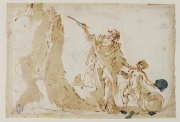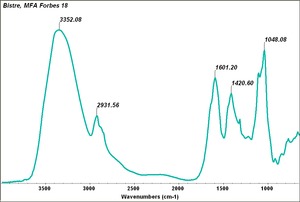Bister
Jump to navigation
Jump to search
Description
A yellowish, dark brown, transparent pigment used in pen and wash drawings and watercolor paintings from the 14th to the 19th centuries. Bister, also called bistre, is the dried water extract from the tarry soot of burnt resinous woods, especially Beech wood. It has fair permanence and will fade in direct sunlight.
Synonyms and Related Terms
beechwood soot; bistre (Br.); bistro (It.); beech black; fuligo; guligino; caligo; charcoal black; brown lampblack; soot brown; brown lake
Additional Images
Resources and Citations
- R.White "Brown and Black Organic Glazes, Pigments and Paints" National Gallery Technical Bulletin, 10:58-71, 1986.
- R. J. Gettens, G.L. Stout, Painting Materials, A Short Encyclopaedia, Dover Publications, New York, 1966
- G.S.Brady, Materials Handbook, McGraw-Hill Book Co., New York, 1971 Comment: p. 610
- Reed Kay, The Painter's Guide To Studio Methods and Materials, Prentice-Hall, Inc., Englewood Cliffs, NJ, 1983
- Ralph Mayer, A Dictionary of Art Terms and Techniques, Harper and Row Publishers, New York, 1969 (also 1945 printing)
- R.D. Harley, Artists' Pigments c. 1600-1835, Butterworth Scientific, London, 1982
- Random House, Webster's Encyclopedic Unabridged Dictionary of the English Language, Grammercy Book, New York, 1997
- John S. Mills, Raymond White, The Organic Chemistry of Museum Objects, Butterworth Heineman, London, 2nd ed., 1994
- The American Heritage Dictionary or Encarta, via Microsoft Bookshelf 98, Microsoft Corp., 1998 Comment: bister
- Encyclopedia Britannica, http://www.britannica.com Comment: bistre
- Art and Architecture Thesaurus Online, http://www.getty.edu/research/tools/vocabulary/aat/, J. Paul Getty Trust, Los Angeles, 2000 Comment: bister
- The Dictionary of Art, Grove's Dictionaries Inc., New York, 1996 Comment: "Pigment"


